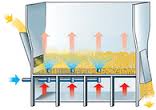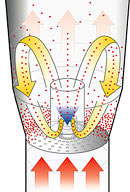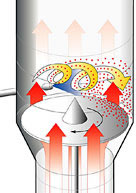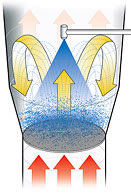Fluid Bed Coaters
Fluid Bed Coaters are used in coating materials by the fluid bed technology. With fluid bed coating, particles are fluidized and the coating fluid sprayed on and dried. Small droplets and a low viscosity of the spray medium ensure an even product coating.
Process advantages
Uniform, continuous product coating. Aqueous or organic coatings can be applied. Coating and drying take place in one machine.
In terms of Total Containment, the coating process and the filling and emptying of the machine can be carried out in complete isolation and without product spreading into the environment.
When using organic solvents, the process machines can also be made inert and used with a solvent recovery system.
Fluid Bed Coating
Spray coating can be used for all fluid bed systems, be it in batch or continuous operation or if the film is applied from a sprayed solution, suspension or hot melt. For this processing option the parameters have to be chosen to avoid agglomeration, i.e. liquid bridges between the air suspended particles. If spraying a solution or suspension the liquid only serves as a vehicle to deliver the coating material to the surface of the substrate. For hot melt coating the droplets must be small enough not to form solid bridges.
The quality of the coating extensively depends on the statistical residence time of the particles in the coating zone. For a classic fluid bed unit only top-spray coating is possible. Bottom-spray or tangential-spray coating inserts can also be hosted by means of the relevant technical provisions.
Types
Bottom-Spray Coating
This processing option uses the energies and controls of the fluid bed to create a pneumatic mass transport inside a special insert, which consists of a perforated bottom screen with defined free areas. Most of the process air is channeled through the center via a tube, as such producing a venturi effect, which sucks the product from outside the partition past the spray nozzle. Leaving the cylindrical partition and entering the conical expansion chamber the particle velocity is dramatically reduced, excess moisture is rapidly evaporated with the dry product returning again and again through the coating zone to receive more coating material. This uniform statistical residence time of all particles in the coating zone results in a very homogenous coating. Due to the high kinetic energy provided by the pneumatic mass flow moist particles are separated, as such allowing the individual coating of even very small particles. Due to the nozzle being positioned directly inside the product and concurrently spraying a premature viscosity change of the coating droplet is avoided. All this features result in the highest possible coating quality, which is imperatively required to produce defined and reproducible drug delivery profiles.
Tangential Spray Coating
This processing technique is with its physical principles quite similar to bottom-spray coating, only that the production motion is provided by a motor driven rotor disc. Otherwise, the quality producing parameters are the same: Uniform statistical residence time is warranted by defined rotor revolution speed. The coating material is sprayed concurrently inside the rotating product. The rolling motion of the particles provide an even higher separation force, as such preventing agglomeration. However, this high kinetic energy makes it somewhat difficult to coat very small particles and is generally destructive for larger and non-spherical products. The benefits of this processing option are mainly for the layering and subsequent filmcoating of pellets.
Top-Spray Coating
This processing option is frequently used by the food, feed and chemical industries as the function of the film mainly serves to improve the general handling or storage times, i.e. time limited protection against moisture, oxygen or light. A perfect film is generally not required for this function, but care must be taken that the droplets do not become too viscous before touching the substrate, in order to maintain a good spreadability. As however neither the particle motion, nor the travel distance of droplet from nozzle to substrate are uniform the film structure is generally rather porous, but nevertheless measuring up to the above described requirements.
Video



